Uzbekistan Part III - The Treasure Chest of Bukhara
 |
| Eating traditional 'laghman' on tapchan at Lyabi Hauz |
Big, beautiful Bukhara is one of those unforgettable places, overwhelming in magnificent sights and majestic buildings, in its desert setting. It’s all about the four M’s – mosques, minarets, mausoleums and madrassas.
Our little traditional hotel (not flash but functional), whose rooms all faced inwards to a garden courtyard, was in the historical centre. This small section of town was in past times the old Jewish quarter, and only steps away from the Lyabi Hauz, Bukhara’s central square, positioned around a historic pool shaded in places by mulberry trees hundreds of years old and overlooked by age-old madrassas at both ends.
 |
| The size of this van gives an idea of the scale of Bukhara's monuments |
Out here in this ancient desert town, temperatures were stiflingly hot by midday, and by afternoon the streets and mudbrick alleyways became deserted as cool respite was sought indoors. Only a handful of brazen (or idiotic?) tourists were brave enough to venture the baked streets at this time - us included. We tried it once on our arrival and daren’t repeat it. Siestas became the order of the day after that.
By night, as temperatures dropped to a tolerable warmth the town centre came alive as people socialized and strolled around its illuminated sights, now escaping the heat in their homes. Icecreams were relished, babies in prams pushed, cigarettes smoked, and tea drunk at the local chaikanas (teahouses). People sat around the pools and small canals that survived the Soviet era. Bukhara’s many medieval pools, used for drinking and washing, became plague-ridden over the centuries and a large number were closed and replaced by water channels when the Soviets moved in.
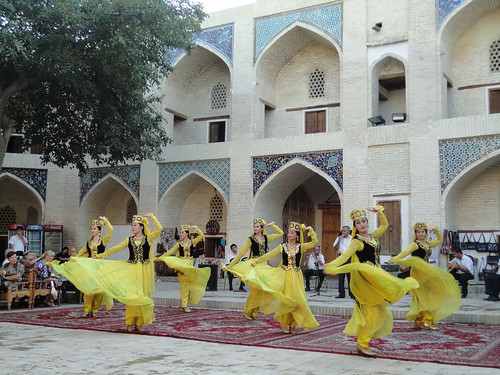 |
| Folkloric show in one of Bukhara's madrassas |
We hired a young guide in his mid-twenties to take us around Bukhara’s many historical treasures. It was like discovering a jewel box of delights as we absorbed the history and stories of these monuments. There was the Ismail Samani mausoleum (my favourite piece of architecture with its delicate detailed brickwork), the imposing Ark (fortress of past rulers) with its towering crennelated mudbrick walls, the understated Spring of Job, the beautiful Kalon Minaret of exquisite pale patterned bands, the huge Abdul Aziz Madrassa, the Bolo-Hauz Mosque with its unusual tall slender carved wooden pillars and many other monuments. All these and more were within easy walking distance of each other.
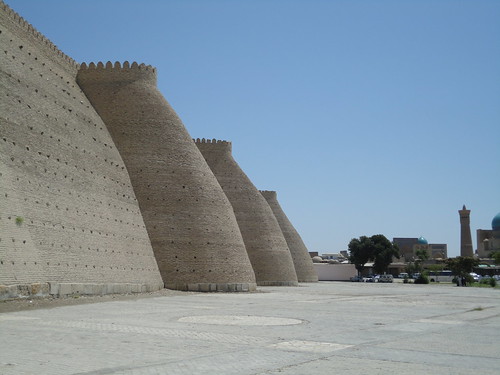 |
| The fortified walls of the Ark |
Rustam, our guide, was very informative with detail. We listened as he explained how learning English, or another foreign language, (French would be ideal as they are the largest contingent of tourists to Uzbekistan), is the best available option for them so that the young generation may make a living from tourism. His wife had also learnt English and worked with tourists as a guide. For US$20 you can hire a private guide that will fill you in on more knowledge, facts, history and local myths than you could possibly remember. It seems as though tourism equals dollars, more than one could earn in a regular job.
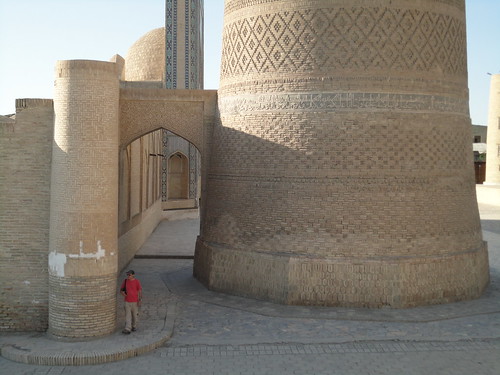 |
| Max is dwarfed by Bukhara's streetscape |
Bukhara is also about bazaars and handicrafts. The bazaars of old, now restored, once specialised in particular crafts – there was the jewellery bazaar, the hat bazaar, and so on. There was even a moneychangers’ bazaar for merchants from faraway lands who passed through on their trading route. Nowadays, craftsmen show their skills and wares to tourists. Smiths and engravers work with all kinds of metal (iron, silver, brass and copper, mainly), there are gorgeous carpets and rugs, silks and fabrics in bright bold colours, wood carvings, lacquered boxes with painted oriental scenes and ceramics of brilliant blues and greens. A huge range of souvenirs is sold under the cool domed archways and arcades. A long-standing hammam (Turkish massage and bath house) still operates from one of these bazaars with men-only days and women-only days displayed in the doorway. Foot massage and foot reflexology is practised here as a therapy.
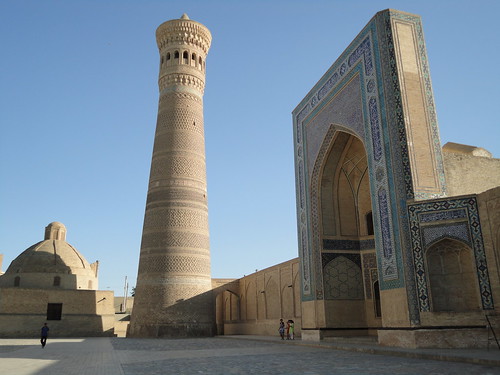 |
| The beautiful, striped Kalon Minaret |
It was in Bukhara that we were introduced to Uzbekistan’s national dish, plov. This is a rice, or pilaf, dish cooked with mutton, fried onions, carrots, raisins, barberries (tarty in flavour like cranberries), pine nuts, seasonings and lots of mutton fat over a large pot on a fire. It is traditionally cooked only by Uzbek men and friendly rivalry exists as to who can make the best. Marat, our driver, took us to a terrific local plov restaurant at an off-the-tourist-trail location that specialised in this dish. Outside at the open air kitchen an enormous cauldron over an open fire had been just about emptied of plov by many diners sitting inside the restaurant’s cavernous but cool interior. The place was a huge unadorned white space of plain tables and chairs, but everyone was there for the lunchtime plov not the décor. It was delicious and accompanied by icy-cold berry juice and, as always with every Uzbek meal, a pot of tea in blue and white china decorated with the cotton plant motif.
 |
| Chor Minor madrassa |
Our sojourn in Bukhara was impressive – an architectural feast for the eyes with a fascinating history. Although there are all the modern conveniences of internet, mobile phones and satellite TV, in a place like Bukhara it is easy to imagine life in centuries past – colourful, noisy and crowded bazaars, laden camels and donkeys plodding through baked mud alleys, and grand towers and blue domes rising above throngs of sellers with carpets, silks and trinkets. Onward bound now for the holy city of Khiva.









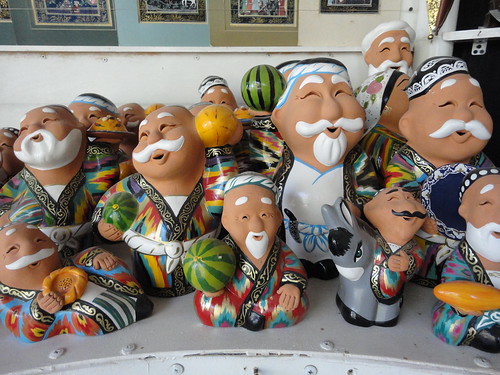
 Hi, I'm Eva - world traveller, cultural explorer and experience seeker. Together with my husband Max, we've been globetrotting for over 20 years.
Hi, I'm Eva - world traveller, cultural explorer and experience seeker. Together with my husband Max, we've been globetrotting for over 20 years.







0 comments: